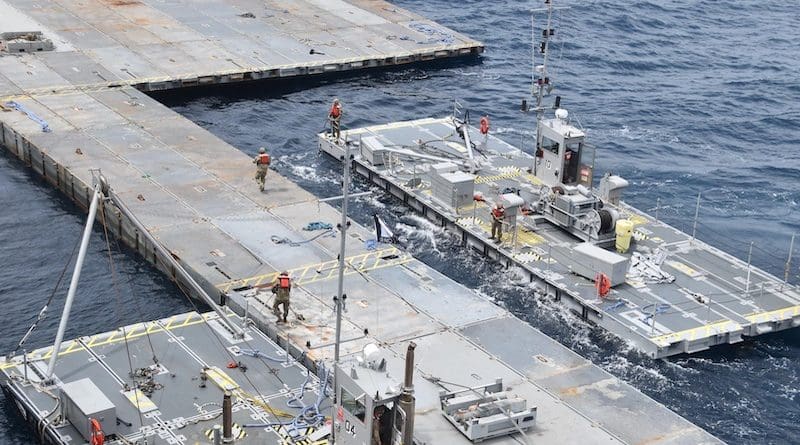US Says Using Unfavorable Sea Conditions To Gain Efficiencies On Gaza Aid Mission
By DoD News
By C. Todd Lopez
While unfavorable sea conditions have slowed deployment of two piers meant to deliver humanitarian aid into Gaza, the Defense Department has found a way to use the delay to its advantage and get ahead on the mission once it gets underway.
Earlier this week the Defense Department announced completion of the construction of two floating piers, which will be used to deliver humanitarian aid into Gaza.
Construction of the Joint Logistics Over-the-Shore, or JLOTS, system on the Mediterranean Sea was completed Tuesday. One floating pier will be deployed several miles offshore outside Gaza, while the other, called the Trident pier, or “causeway,” will be pushed onto and attached to the Gazan shore. Together they will be used to move humanitarian aid into Gaza.
Both of the floating piers, along with the MV Roy P. Benavidez — a large, medium-speed, roll-on, roll-off ship — are off the coast of Israel near the Port of Ashdod, about 18 miles north of Gaza. Unfavorable sea conditions prevent movement of the piers to their final location.
In the meantime, the MV Sagamore — a commercial cargo ship — has been loaded with humanitarian aid in Cyprus and has made its way to Ashdod. Instead of waiting for the piers to be deployed, humanitarian aid on the Sagamore will be moved to the Benavidez so that the Sagamore can go back to Cyprus to get more aid supplies, said Pentagon Press Secretary Air Force Maj. Gen. Pat Ryder.
“In this period of time that we have before the pier becomes operational, we’re essentially using that time to get ahead,” Ryder said during a briefing today. “Since the Sagamore has been loaded with humanitarian assistance, by transloading that on to the Benavidez, the Benavidez is essentially in position to immediately start loading that onto the floating pier for subsequent shipment to the causeway and delivery to the shore.”
Because the Benavidez will remain near Gaza when the humanitarian mission begins, Ryder said, the Sagamore is free to go back to Cyprus to get additional aid.
Once the two floating piers are deployed, ships loaded with humanitarian aid will dock at the floating pier off the coast of Gaza and have their cargo unloaded onto trucks that are onboard Army-owned landing craft utility ships, or LCUs, and logistic support vessels, or LSVs.
The Army ships will then travel toward Gaza where they will meet up with the Trident pier. There, the trucks onboard the LCUs and LSVs will drive onto the pier and onto the shore of Gaza where the humanitarian aid supplies can then be staged for delivery inside Gaza. Ryder said non-U.S. civilian contractors will be responsible for driving those vehicles.
It’s expected that initially about 90 truckloads of supplies will transit the causeway each day and make their way into Gaza. When the operation reaches full capacity, as many as 150 trucks will make their way into Gaza daily.
“This is a complex operation which requires close coordination with many partners,” said Ryder. “The United States is joining an international community-backed effort, led by [U.S. Agency for International Development] with support from the United Nations, the World Food Programme, the Republic of Cyprus, other partner nations and the [Israeli Defense Forces] to expand the delivery of humanitarian assistance via a maritime corridor to the people of Gaza.”

